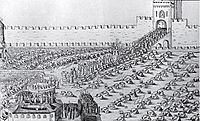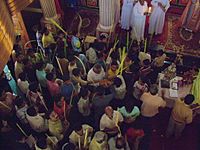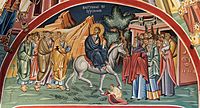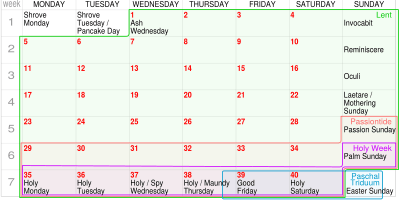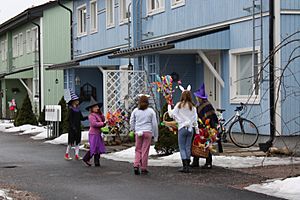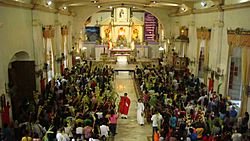Palm Sunday facts for kids
Quick facts for kids Palm Sunday |
|
|---|---|
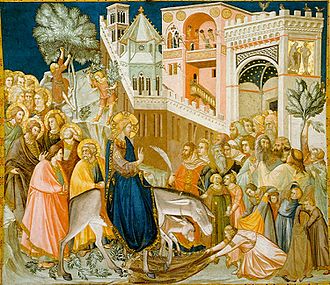
Entry of Christ into Jerusalem (1320) by Pietro Lorenzetti: entering the city on a donkey symbolizes arrival in peace rather than as a war-waging king arriving on a horse.
|
|
| Significance | commemorates Jesus' triumphal entry into Jerusalem |
| Date | Moveable feast, Sunday before Easter |
| 2024 date |
|
| 2025 date |
|
| 2026 date |
|
| 2027 date |
|
Palm Sunday is a Christian festival day. It is always happens on a Sunday but the date each year changes. It is a day to celebrate the day that Jesus entered the city of Jerusalem in Israel as was written about in the Bible in Mark 11:1-11, Matthew 21:1-11, Luke 19:28-44, and in John 12:12-19. During Palm Sunday many Christians celebrate with Crosses made out of Palm leaves and by going to church.
Contents
Observance in the liturgy
Eastern and Oriental Christianity
Palm Sunday, or the "Entry of the Lord into Jerusalem" as it may be called in Orthodox Churches, is one of the Twelve Great Feasts of the liturgical year. The day before Palm Sunday, Lazarus Saturday, believers often prepare palm fronds by knotting them into crosses in preparation for the procession on Sunday. The hangings and vestments in the church are changed to a festive color – most commonly green.
The Troparion of the Feast (a short hymn) indicates that the resurrection of Lazarus is a prefiguration of Jesus's own Resurrection:
O Christ our God
When Thou didst raise Lazarus from the dead before Thy Passion,
Thou didst confirm the resurrection of the universe.
Wherefore, we like children,
carry the banner of triumph and victory,
and we cry to Thee, O Conqueror of love,
Hosanna in the highest!
Blessed is He that cometh
in the Name of the Lord.
In the Russian Orthodox Church, Ukrainian Orthodox Church, Ukrainian Catholic Church, Ruthenian Catholic Church, Polish, Bavarian and Austrian Roman Catholics, and various other Eastern European peoples, the custom developed of using pussy willow instead of palm fronds because the latter are not readily available that far north. There is no canonical requirement as to what kind of branches must be used, so some Orthodox believers use olive branches. Whatever the kind, these branches are blessed and distributed together with candles either during the All-Night Vigil on the Eve of the Feast (Saturday night), or before the Divine Liturgy on Sunday morning. The Great Entrance of the Divine Liturgy commemorates the "Entry of the Lord into Jerusalem", so the meaningfulness of this moment is punctuated on Palm Sunday as everyone stands, holding their branches and lit candles. The faithful take these branches and candles home with them after the service, and keep them in their icon corner as an evloghia (blessing).
In Russia, donkey walk processions took place in different cities, but most importantly in Novgorod and, from 1558 until 1693, in Moscow. These were prominently featured in testimonies by foreign witnesses and mentioned in contemporary Western maps of the city. The Patriarch of Moscow, representing Christ, rode on a "donkey" (actually a horse draped in white cloth); the Tsar of Russia humbly led the procession on foot. Originally, Moscow processions began inside the Kremlin and terminated at Trinity Church, now known as Saint Basil's Cathedral, but in 1658 Patriarch Nikon reversed the order of procession. Peter I in the 1720s, as a part of his nationalisation of the church, terminated the custom; it has been occasionally recreated in the 21st century.
In Oriental Orthodox churches, palm fronds are distributed at the front of the church at the sanctuary steps. In India the sanctuary itself is strewn with marigolds, and the congregation proceeds through and outside the church.
- Palm Sunday in Eastern and Oriental Christianity
-
Palm Sunday procession, Moscow, with Tsar Alexei Michaelovich (painting by Vyacheslav Schwarz, 1865)
-
Orthodox congregation in India collects palm fronds for procession: men on left of sanctuary in the photo; women collecting fronds on right of sanctuary, outside photo.
-
Eastern Orthodox fresco in Nativity of the Theotokos Church, Bitola, Republic of North Macedonia
Western Christianity
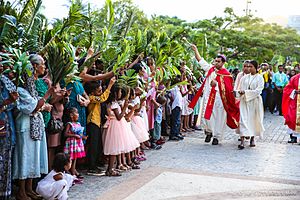
In ancient times, palm branches symbolized goodness and victory. They were often depicted on coins and important buildings. Solomon had palm branches carved into the walls and doors of the temple (1 Kings 6:29). Again at the end of the Bible, people from every nation raise palm branches to honor Jesus (Revelation 7:9).
Palm Sunday commemorates the entrance of Jesus into Jerusalem (Matthew 21:1–9), when palm branches were placed in his path, before his arrest on Holy Thursday and his crucifixion on Good Friday. It thus marks the beginning of Holy Week, the final week of Lent.
In the Roman Catholic Church, as well as among many Anglican and Lutheran congregations, palm fronds (or in colder climates some kind of substitutes) are blessed with an aspergillum outside the church building in an event called the "blessing of palms" if using palm leaves (or in cold climates in the narthex when Easter falls early in the year). A solemn procession also takes place, and often includes the entire congregation.
In the Catholic Church and the Episcopal Church, this feast now coincides with that of Passion Sunday, which is the focus of the Mass which follows the palms ceremony. The palms are saved in many churches to be burned on Shrove Tuesday the following year to make ashes used in Ash Wednesday services. The Catholic Church considers the blessed palms to be sacramentals. The vestments for the day are deep scarlet red, the colour of blood, indicating the supreme redemptive sacrifice Christ was entering the city to fulfill: his Passion and Resurrection in Jerusalem.
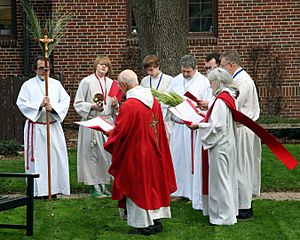
In the Episcopal and many other Anglican churches and in Lutheran churches, as well, the day is nowadays officially called "The Sunday of the Passion: Palm Sunday"; in practice, though, it is usually termed "Palm Sunday" as in the 1928 American Book of Common Prayer and in earlier Lutheran liturgies and calendars, to avoid undue confusion with the penultimate Sunday of Lent in the traditional calendar, which was "Passion Sunday".
In the Church of Pakistan (a member of the Anglican Communion), the faithful on Palm Sunday carry palm branches into the church as they sing Psalm 24.
In many Protestant churches, children are given palms, and then walk in procession around the inside of the church . In traditional usage of the Methodist Church, The Book of Worship for Church and Home (1965) provides the following Collect for Palm Sunday:
Almighty and everlasting God, who, of thy tender love toward mankind hast sent thy Son our Savior Jesus Christ to take upon him our flesh, and to suffer death upon the cross, that all mankind should follow the example of his great humility: Mercifully grant that we may both follow the example of his patience and also be made partakers of his resurrection; through the same Jesus Christ our Lord. Amen.
In Spanish, it is sometimes called Pascua florida, and it was from this day in 1512 that the state of Florida received its name.
Customs
It is customary in many churches for worshippers to receive fresh palm leaves on Palm Sunday. In parts of the world where this has historically been impractical, substitute traditions have arisen.
Belgium
In Hoegaarden, one of the last remaining Palm Sunday processions takes place every year. A fellowship of Twelve Apostles carries a wooden statue of Christ around the town, while children go door to door offering the palms (box) for coins.
Bulgaria
In Bulgaria, Palm Sunday is known as Tsvetnitsa (tsvete, "flower") or Vrabnitsa (varba, "willow"), or Flower's Day. People with flower-related names (e.g., Lilia, Margarita, Nevena, Ralitsa, Rosa, Temenuzhka, Tsvetan, Tsvetana, Tsvetelin, Tsvetelina, Tsvetko, Violeta, Yavor, Zdravko, Zjumbjul, etc.) celebrate this day as their name day.
England
In the 15th through the 17th centuries in England, Palm Sunday was frequently marked by the burning of Jack-'o'-Lent figures. This was a straw effigy which would be stoned and abused on Ash Wednesday, and kept in the parish for burning on Palm Sunday. The symbolism was believed to be a kind of revenge on Judas Iscariot, who had betrayed Christ. The effigy could also have represented the hated figure of Winter, whose destruction prepares the way for Spring.
Ethiopia
In Orthodox Ethiopia, this holiday is referred to as Hosanna. Palm leaves will be blessed and distribute, they are used to create crucifixes, rings and other ornaments.
Finland
In Finland, it is popular for children to dress up as Easter witches and go door to door in neighborhoods and trade decorated pussy willow branches for coins and candy. This is an old Karelian custom called virpominen.
It is customary for the children to chant, with some variation, "Virvon varvon tuoreeks, terveeks, tulevaks vuodeks, vitsa sulle, palkka mulle!" which translates as "I'm wishing you a fresh, healthy upcoming year, a branch for you, a prize for me!" The chant has been translated in Juha Vuorinen's novel Totally Smashed! as "Willow switch, I'm the Easter witch! I wish you health and a love that's rich! From me I bring some luck today, for this branch what will you pay?"
India
In most of the Catholic churches in India the palms are blessed by the priest on Palm Sunday and then distributed among the people after the holy mass. There is a tradition of folding palm fronds into palm crosses, which are kept at the altar till the next Ash Wednesday.
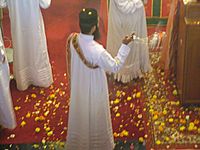
In the South Indian state of Kerala (and in Indian Orthodox, Church of South India (CSI), Syro-Malankara Catholic Church, and Syriac Orthodox Church (Jacobite) congregations elsewhere in India and throughout the West), flowers are strewn about the sanctuary on Palm Sunday during the reading of the Gospel, at the words uttered by the crowd welcoming Jesus, "Hosanna! Blessed is he who is come and is to come in the name of the Lord God". These words are read to the congregation thrice. The congregation then repeats, "Hosanna!", and the flowers are scattered. This is adapted from the older Hindu custom of scattering flowers on festive occasions, as well as the honour shown to Jesus upon his entry into Jerusalem.
Indian Orthodoxy traces its roots to the arrival in India of Saint Thomas the Apostle (traditionally dated to AD 52) and his evangelism among both the Brahmans of the Malabar Coast and the ancient Jewish community there. Its rites and ceremonies are both Hindu and Jewish, as well as Levantine Christian, in origin. In Syro-Malabar Catholic Church's palm leaves are blessed during Palm Sunday ceremony and a Procession takes place holding the palms..
Italy
In Italy, palm leaves are used along with small olive branches, readily available in the Mediterranean climate. These are placed at house entrances (for instance, hanging above the door) to last until the following year's Palm Sunday. For this reason, usually palm leaves are not used whole, due to their size; instead, leaf strips are braided into smaller shapes. Small olive branches are also often used to decorate traditional Easter cakes, along with other symbols of birth, like eggs.
Latvia
In Latvia, Palm Sunday is called "Pussy Willow Sunday", and pussy willows – symbolizing new life – are blessed and distributed to the faithful. Children are often awakened that morning with ritualistic swats of a willow branch.
Lithuania
When Christianity came to Lithuania, the plants which sprouted earliest were honored during spring feasts. The name "Palm Sunday" is a misnomer; the "verba" or "dwarfed spruce" is used instead. According to tradition, on the Saturday before Palm Sunday the Lithuanians take special care in choosing and cutting well-formed branches, which the women-folk decorate with flowers. The flowers are meticulously tied onto the branches, making the "Verba".
The Levant
In Israel, Jordan, Lebanon, Palestine, and Syria, Palm Sunday (Shaa'nineh in Arabic) Is perhaps the best-attended service in the Christian Calendar, among the Orthodox, Catholic (Latin and Eastern), and Anglican Churches, perhaps because it is notably a family occasion. On this day, children attend church with branches from olive and palm trees. Also, there will be carefully woven crosses and other symbols made from palm fronds and roses and a procession at the beginning of the service, during which at some point, the priest will take an olive branch and splash holy water on the faithful.
Malta
All the parishes of Malta and Gozo on Palm Sunday (Maltese: Ħadd il-Palm) bless the palm leaves and the olive leaves. Those parishes that have the statues of Good Friday bless the olive tree they put on the statues of "Jesus prays in the Olive Garden" (Ġesù fl-Ort) and the "Betrayal of Judas" (il-Bewsa ta' Ġuda). Also, many people take a small olive branch to their homes because it is a sacramental.
Netherlands
In the Saxon regions of the Netherlands, crosses are decorated with candy and bread, made in the form of a rooster. In the Diocese of Groningen-Leeuwarden, a great procession with oil lamps is held the night before Palm Sunday in honour of the Sorrowful Mother of Warfhuizen.
Philippines
In the Philippines, a statue of Christ riding a donkey (the Humenta), or the presiding priest on horseback, is brought to the local church in a morning procession. Congregants line the route, waving palaspás (ornately woven palm branches) and spreading tapis (heirloom "aprons" made for this ritual) in imitation of the excited Jerusalemites. At the church parvise, a house, or the town plaza, children dressed as angels scatter flowers as they sing the day’s antiphon Hosanna Filio David in the vernacular and to traditional tunes. The first Mass of the day then follows.
Once blessed, the palaspás are brought home and placed on altars, doorways, and windows. The Church teaches that this is a sign of welcoming Christ into the home, but folk belief holds that the blessed palaspás are apotropaic, deterring evil spirits, lightning, and fires. Another folk custom is to feed pieces of blessed palaspás to roosters used in sabong (cockfighting); this was strongly discouraged by the Archbishop of Manila, Cardinal Luis Antonio Tagle. In other provinces, the flowers strewn by the angels during the procession are added to the rice seeds being planted, in the belief that these will ensure a bountiful harvest.
Poland

Many Polish towns and villages (the best known are Lipnica Murowana in Lesser Poland and Łyse) organize artificial palm competitions. The biggest of those reach above 30 meters in length; for example, the highest palm in 2008 was 33.39 meters.
Romania and Moldova
In Romania and Moldova, Palm Sunday is known as Duminica Floriilor or simply Florii, translating Flowers' Sunday.
Spain
In Spain, there is a tradition at the Palmeral of Elche (Europe's largest palm grove) in which local people cover palm leaves from the sun to allow them to whiten, and then they tie and braid them into intricate shapes.
A Spanish rhyming proverb states: Domingo de Ramos, quien no estrena algo, se le caen las manos ("On Palm Sunday, the hands drop off of those who fail to wear something new"). On Palm Sunday, it is customary to don new clothing or shoes.
Syria
In Syria, it is popular for children to dress up as Easter witches and go door to door in neighborhoods for coins and candy.
Wales
In Wales, Palm Sunday is called 'Sul y Blodau' ('Flowering Sunday') and it is traditional to decorate graves with flowers on that day, especially in the industrial towns and villages of south Wales.
Related pages
Images for kids
-
"Flevit super illam" (He wept over it); by Enrique Simonet, 1892
-
Palm Sunday in Malankara Church (Oriental Orthodox) of Kerala – People holding tender leaves of coconut palms (kuruthola) and flowers are thrown upwards during Gospel reading
See also
 In Spanish: Domingo de Ramos para niños
In Spanish: Domingo de Ramos para niños



